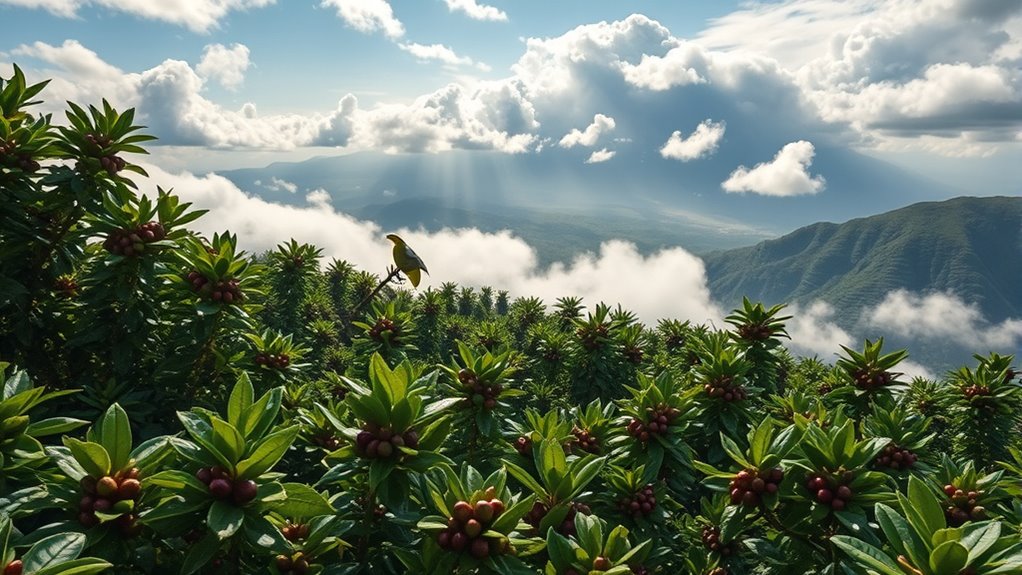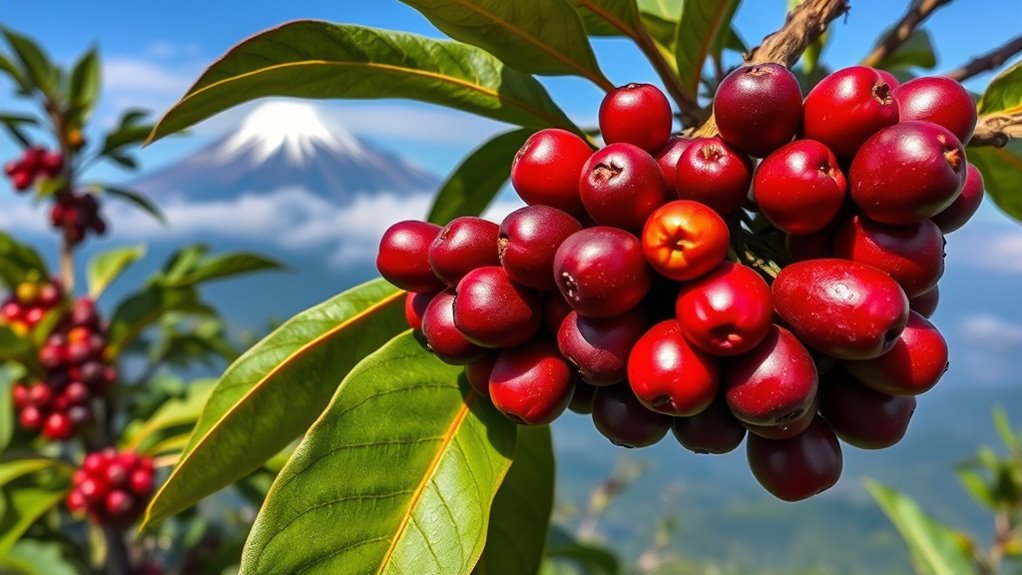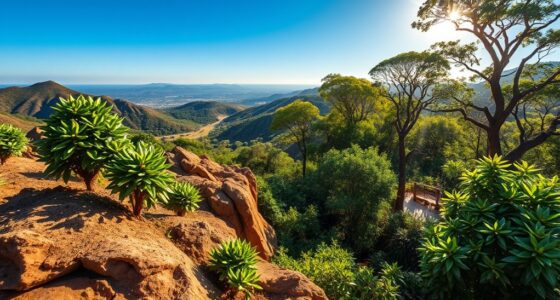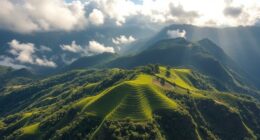Tanzania’s high-altitude climate and microclimates around Kilimanjaro markedly influence its coffee beans, especially the rare peaberries. The cool, stable weather slows cherry ripening, creating complex flavors and vibrant acidity in each cup. Peaberries develop concentrated, intense notes, making them highly sought after. If you want to discover how these climatic factors and bean types shape Tanzania’s unforgettable coffee, there’s much more to explore behind the fascinating cultivation process.
Key Takeaways
- Peaberries are rare, concentrated coffee beans resulting from a natural mutation, offering intense flavor and unique brewing qualities.
- Kilimanjaro’s high-altitude climate slows cherry ripening, enhancing coffee’s complex flavors and vibrant acidity.
- The mountain’s shaded, cool environment contributes to the development of nuanced aromas in Tanzanian coffee.
- Microclimates around Kilimanjaro influence bean characteristics, creating distinct profiles for different regions.
- Sustainable farming practices in Kilimanjaro’s environment protect land quality and support premium, eco-friendly coffee production.

Tanzania’s coffee is renowned for its rich flavor and high quality, making it a favorite among coffee enthusiasts worldwide. When you explore its origins, you’ll find that the journey from bean to cup involves careful coffee harvesting and a commitment to sustainable farming practices. The country’s diverse climate and fertile soils create ideal conditions for growing premium Arabica beans, and local farmers often prioritize sustainable farming to protect the environment and ensure long-term productivity.
During coffee harvesting in Tanzania, you’ll notice that the process is meticulous. Ripe cherries are carefully picked by hand, often selecting only those that are perfectly ripe. This selective harvesting ensures that the beans develop their full flavor potential. The focus on sustainable farming isn’t just about preserving the land; it also involves using eco-friendly methods, reducing chemical use, and conserving water. Many farmers work with cooperatives to implement environmentally sound practices that benefit both their communities and future harvests.
Careful hand-picking and eco-friendly farming practices ensure Tanzanian coffee’s rich, sustainable flavor.
Kilimanjaro’s climatic influence plays a significant role in shaping the unique character of Tanzanian coffee. The mountain’s high-altitude environment creates a cool, stable climate that slows the ripening process of coffee cherries, allowing the beans to develop complex flavors. This prolonged maturation results in a cup that’s bright, with vibrant acidity and nuanced aromas. The mountain’s influence also means that the coffee is often grown in shaded conditions, which promotes biodiversity and reduces the need for artificial interventions. These natural conditions contribute to the high quality and distinctive taste profile that coffee lovers seek.
In addition to the altitude, Tanzania’s varied microclimates across regions like Kilimanjaro, Mbeya, and Arusha give each coffee a distinct flavor profile. The combination of climate, soil, and altitude influences the size and shape of the beans, including the rare peaberries—single, rounded beans that often yield a more concentrated and flavorful brew. Farmers who focus on sustainable practices tend to produce beans with cleaner, more vibrant flavors, emphasizing the importance of responsible cultivation in maintaining the country’s reputation for high-quality coffee.
Ultimately, when you enjoy Tanzanian coffee, you’re tasting the result of a delicate balance between natural climate influences and dedicated, sustainable farming. This harmony not only elevates the flavor but also supports local communities and protects the environment, ensuring that Tanzania remains a top destination for premium coffee for years to come. Additionally, the drainage and soil quality in these regions further enhance the beans’ growth conditions, contributing to their exceptional quality and flavor complexity.
Frequently Asked Questions
How Do Peaberries Affect Coffee Flavor Profiles?
Peaberry flavor tends to be brighter and more concentrated than regular coffee beans. You’ll notice a cleaner, more vibrant taste because peaberries often have a higher density, which impacts roasting and brewing. The harvesting techniques also play a role, as selective picking guarantees only ripe peaberries are collected, enhancing their unique flavor profile. This meticulous process results in a more intense and nuanced coffee experience for you.
What Are the Best Harvesting Practices for Tanzanian Coffee?
You’re guided toward excellence by precise harvesting techniques and careful post-harvest processing. Select ripe cherries by monitoring color and firmness, ensuring only the best are picked—preferably through selective hand harvesting. After harvesting, promptly process the coffee to preserve freshness, whether by wet or dry methods. This attentive approach helps reveal the rich flavors Tanzania’s unique climate and terrain offer, elevating your coffee’s quality and authenticity.
How Does Kilimanjaro’S Altitude Impact Coffee Quality?
Kilimanjaro’s altitude considerably impacts coffee quality through its climatic influence, creating cooler temperatures and high elevations. This altitude impact slows coffee cherry ripening, enhancing flavor complexity and acidity. The cooler climate prevents over-ripening, allowing beans to develop richer aromas and brighter notes. As a result, the climatic influence of Kilimanjaro elevates the overall quality of Tanzanian coffee, making it highly sought after by connoisseurs worldwide.
Are There Specific Tanzanian Coffee Varieties Suited for Peaberry Production?
Imagine a delicate dance, where every step shapes the final note. Tanzanian coffee varieties like Bourbon, Kent, and SL28 lend themselves well to peaberry cultivation techniques, thanks to their unique genetic traits. These varieties, prized for their vibrant flavors, adapt beautifully to peaberry production, enhancing quality and consistency. By selecting specific Tanzanian coffee varieties, you can elevate your peaberry harvest, creating a harmonious symphony of taste and aroma.
How Does Climate Change Threaten Tanzanian Coffee Agriculture?
Climate change threatens Tanzanian coffee agriculture by increasing unpredictability in weather patterns, leading to more frequent droughts and irregular rainfall. This impacts coffee growth, risking lower yields and quality. To adapt, you need to focus on climate adaptation strategies, such as developing drought-resistant coffee varieties and improving water management. Strengthening drought resilience helps protect your coffee crops against climate-related stresses, ensuring sustainable production now and in the future.
Conclusion
As you sip Tanzania’s rich coffee, remember how Kilimanjaro’s cool breezes and the unique peaberries shape each cup. This isn’t just coffee; it’s a voyage through time, blending ancient volcanic soils with modern passion—like discovering a secret passage in your favorite adventure novel. So, next time you enjoy that bold flavor, think of the mountain’s climatic magic and the timeless craft behind every brew. Cheers to Tanzania’s extraordinary coffee journey!









